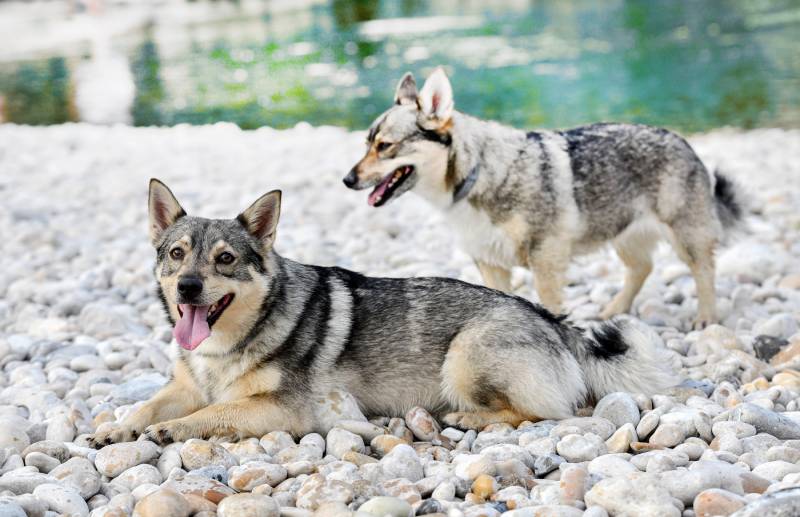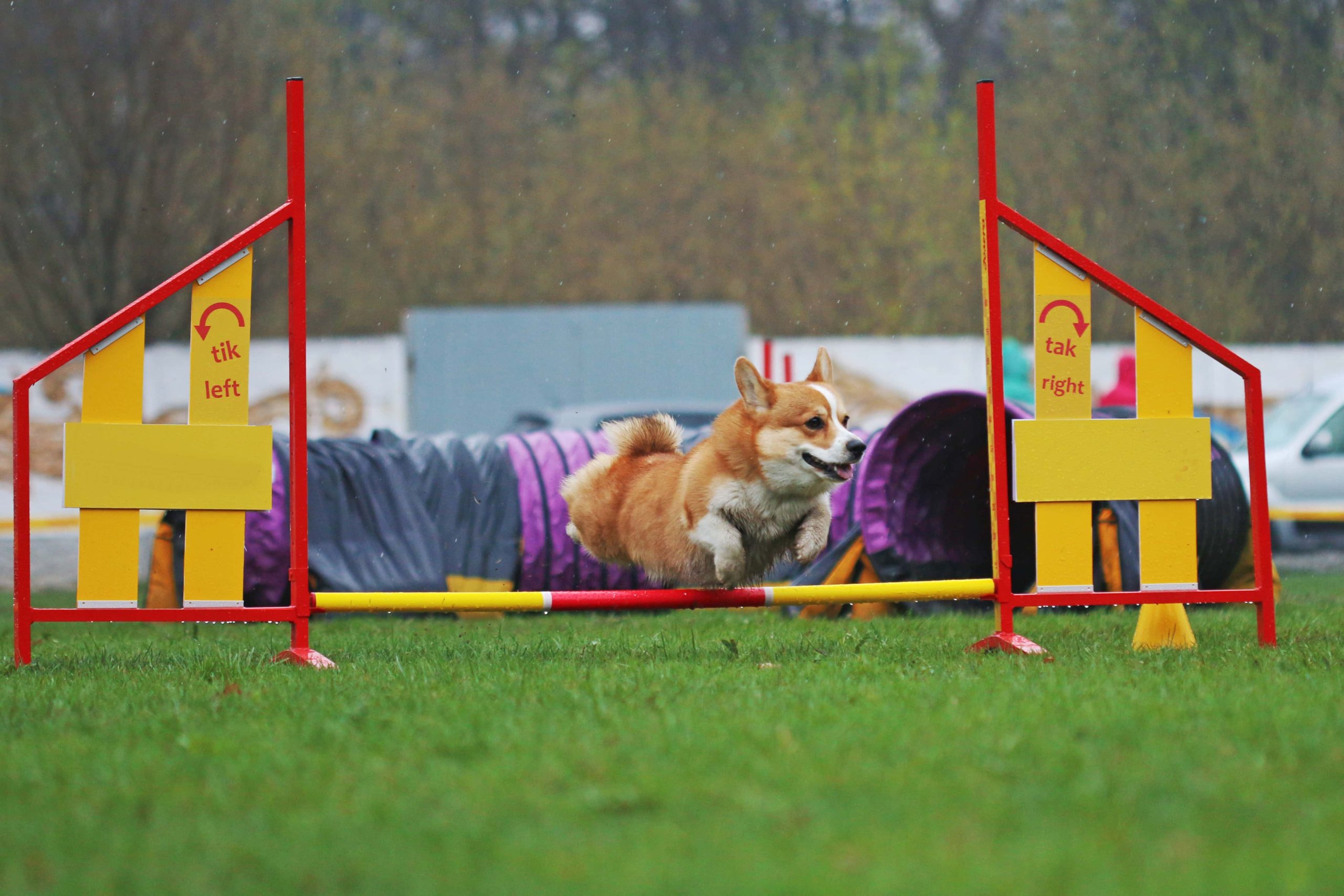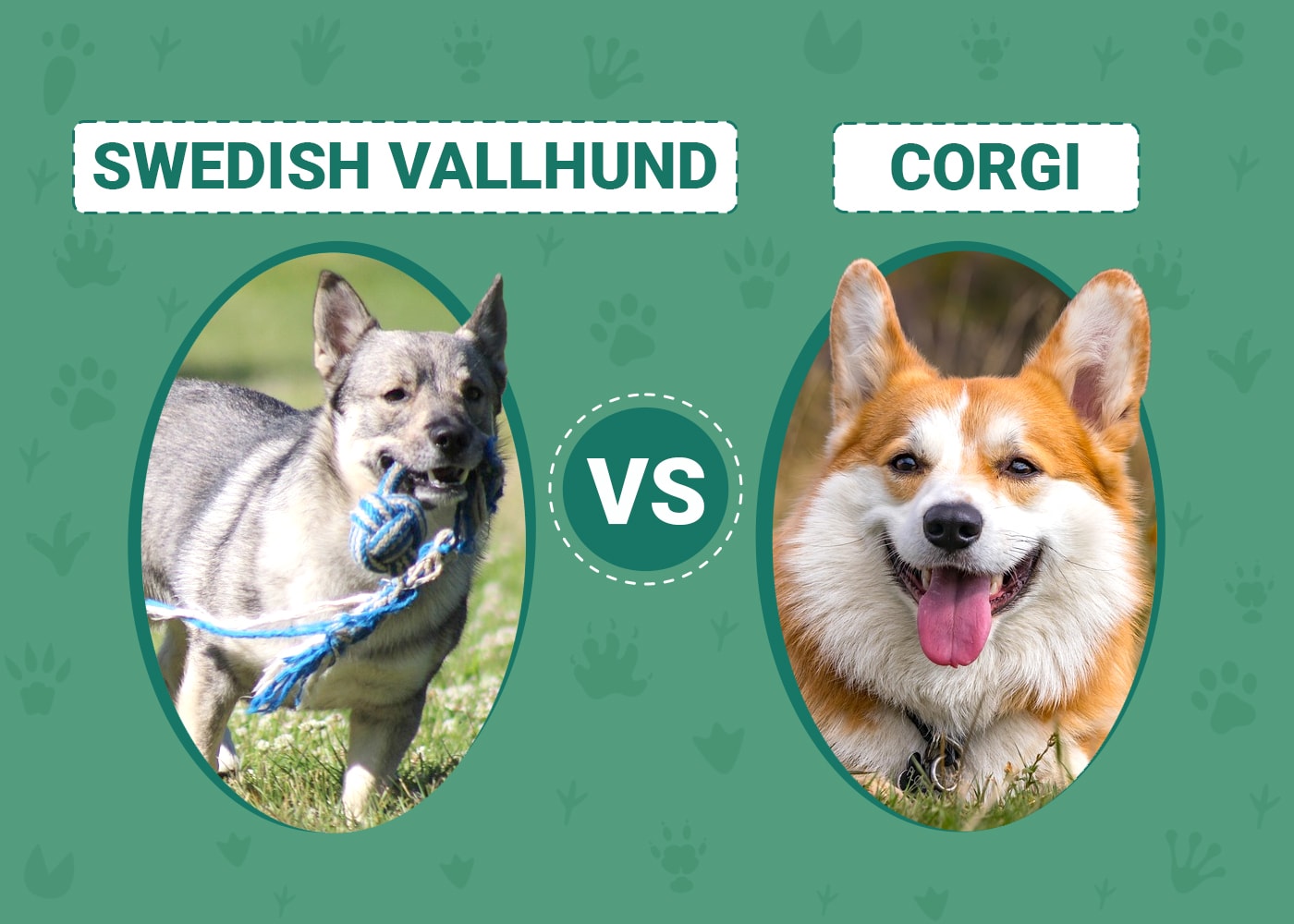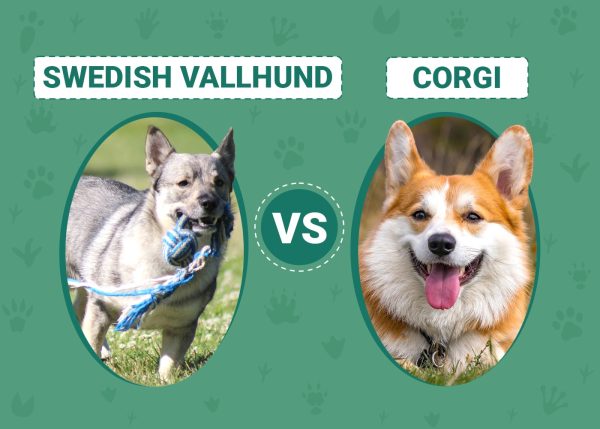Click to Skip Ahead
The Swedish Vallhund and Corgi have numerous similarities. First, they are both built long and low. Among their most prominent features are their short, powerful legs and muscular thighs. Secondly, both breeds are intelligent and have a deep enthusiasm for work.
So, what’s the difference between the Swedish Vallhund and the Corgi? What makes the two breeds unique?
Although they have numerous crossing physical and temperament traits, their bone structure and overall size differ. Moreover, each of the dog breeds has a unique ancestry and history. They are excellent herding dogs, but one is more focused and alert, while the other is friendlier and more laidback.
Today, we will analyze the similarities between these two dog breeds and dive deep into their differences to help you choose the most suitable one for your needs.

Visual Differences

At a Glance
- Average height (adult): 12–14 inches
- Average weight (adult): 20–30 pounds
- Lifespan: 12–15 years
- Exercise: At least 1 hour a day
- Grooming needs: Moderate
- Family-friendly: Yes
- Other pet-friendly: Moderate
- Trainability: Intelligent but stubborn
- Average height (adult): 10–12 inches
- Average weight (adult): 22–35 pounds
- Lifespan: 12–13 years
- Exercise: 2+ hours a day
- Grooming needs: Moderate
- Family-friendly: Yes
- Other pet-friendly: Moderate
- Trainability: Intelligent and eager to please
Swedish Vallhund Overview

Swedish Vallhunds are spitz-type dogs with short legs and sturdy bodies. They are longer than they are tall and have a short, thick coat that comes in gray-yellow, steel gray, gray-brown, red-yellow or red-brown.
Their coats are darker on the back and shoulders and lighter on the muzzle and tummy area. It’s also common for the dogs to have white markings, which are less than one-third of the primary coat hue.
Other features that stand out include the strong pricked ears that make the dog look alert at all times. Vallhunds also have thickly furred tails that curl tightly over the back.
Here is more information about the Swedish Vallhunds.
Personality/Character
Swedish Vallhunds are clever, alert, and lively dogs. They make excellent watchdogs and will let you know if they see or hear something unusual or suspicious. These dogs are also family-oriented and love spending time with their human companions. If lonely or bored, they can develop destructive behaviors.
As active working dogs, Swedish Vallhunds are happier when busy. Although walks can suffice to release pent-up energy, their desire to herd moving objects makes them prone to circling up kids and small pets. These dogs love to nip, which makes them ill-fit for homes with small children. Their intelligence, cheerful and engaging natures make them better for older kids or teens.
Training
Training a Swedish Vallhund can be challenging even though the breed is quite intelligent. These dogs are independent thinkers and prefer acting on their own terms. If you want your pet to obey your commands, you must first earn its trust and build a strong bond. This is sufficient to motivate it to cooperate.
Moreover, you must be firm and consistent with training. Use positive reinforcement methods and offer treats, petting, and praises to get things done your way. You must also socialize your pet to ensure it acts as desired, especially when mingling with strangers and other pets.

Exercise
Vallhunds are highly energetic and have the stamina to keep going even when you think they are tired. Most can stay busy on their own, although you must engage your pet in at least one hour of rigorous play per day. Also, these dogs need mental stimulation to help release pent-up energy.
Health & Care
Vallhunds are generally healthy when bred from parents with all the necessary health clearances. Still, they are purebred dogs with the potential to inherit health problems from their lineage. The most common health concerns seen in the breed include progressive retinal atrophy, hip dysplasia, and patellar luxation.
Breeding
Swedish Vallhunds don’t fit the standard guidelines for when dogs reach physical and sexual maturity. Although they are medium-sized, they mature slowly like large dog breeds. They reach full hormonal and physical maturity at around three years. This is the ideal time to breed your pet for the first time or have it desexed if you don’t want puppies.

Suitable For:
Swedish Vallhunds are playful and energetic dogs with warm personalities. They are family-oriented and always seek treats, praise, hugs, and petting from their loved ones. Also, they love work and are happier after exciting physical and mental stimulation sessions.
Generally, these dogs are unsuitable for first-time pet parents. They are better off with an experienced handler that can provide plenty of training, socialization, and exercise to make them good companions. The ideal pet parent must also have the patience to deal with a headstrong dog.
- Always alert and make excellent watchdogs
- Playful with a warm personality
- Highly intelligent
- Stubborn
- Higher than average potential to case and nip
- Not big enough to offer real physical protection
Corgi Overview

According to the American Kennel Club, Corgis are at rank as the 11th most popular dogs in the United States. They are intelligent and attractive dogs with foxy faces and pointy ears. Compared to Vallhunds, Corgis have shorter, more powerful legs. They are built for work and have great stamina that calls for more physical stimulation.
Like Vallhunds, Corgis were bred as farm and herding dogs. However, while Vallhunds are native to Sweden, Corgis were initially bred in Welsh and spread all over Europe.
Despite the ongoing debates about whether the Swedish Vallhunds came before the Corgis or vice versa, many agree that the two breeds are closely related. After all, they share similarities in their form and were bred as herding dogs.
Here are some critical facts about Corgis.
Personality/Character
Corgis are active, bold, friendly, loyal, and outgoing. They are strong, agile, intelligent, and affectionate without being overly needy. According to fans of the breed, they are large dogs with short legs.
Like Vallhunds, Corgis make excellent watchdogs but are friendlier and more laidback. Another similarity is that these dogs are fond of herding anything that moves. Without proper training, they will herd your kids against their wishes.
Corgis are quite the barkers and can sound an alarm at anything, including shadows. Although training can help nip this annoying behavior in the bud, exercise also helps. If your dog is tired enough, it will not bark at every car that drives down the road.
Training
Corgis love to put their brains to good use. They adore sessions of mental stimulation and will mostly cooperate when learning new tricks. When they don’t, you can motivate them to remain focused using toys, treats, and work opportunities.
The Corgi is perfect for you if you have always wanted to own a clever dog. It is one of the most intelligent dog breeds worldwide, and it’s no wonder it was a favorite choice of the Queen of England. You only need to beware that it is curious and mischievous, which can sometimes make your training seem counterproductive.

Exercise
Corgis are high-energy dogs that require up to two hours of moderate workouts daily. Make sure you split the sessions into three to avoid overstraining their joints. Despite their short statures, they can run at incredibly high speeds, which makes it easier to find games to help release pent-up energy.
Like all herding dogs, Corgis have big brains that should be put to good use. They need mental stimulation as much as they need physical stimulation. Try giving your pet new problems to solve or teach it new tricks. Keeping it mentally engaged can lower its likelihood of herding your kids.
Health & Care
Corgis are generally healthy. Reputable breeders committed to their health and longevity ensure puppies are not at risk of inheriting health issues prone to the breed. Still, you should be on the lookout for issues like cataracts, retinal dysplasia, hip dysplasia, and Von Willebrand’s disease.
Breeding
Corgis are early bloomers and reach sexual maturity at 9 to 11 months. Still, they are not physically mature until 18 to 24 months old. If you want to breed a Corgi, it is best to wait until then. The dog must remain intact until 24 months old because early neutering increases the odds of joint problems.

Suitable For:
Corgis are suitable for active homes where they can receive plenty of physical and mental stimulation. When kept busy, they remain amicable and stay out of trouble. Also, they are happier in homes where they are considered important family members. Corgis don’t like being left out of family activities and prefer being the center of attention.
- Intelligent and relatively easy to train
- Affectionate without being needy
- Reliable watch dogs
- Higher than average need for physical stimulation
- Don’t make the best guard dogs
- Can bark a lot
Which Breed Is Right for You?
The Swedish Vallhund and the Corgi are big dogs in relatively small packages. They are among the most agreeable house pets, treasured for their loyalty, affection, and intelligence. Although they share similarities in their physical attributes and are closely related, they are two unique breeds with a few notable differences.
Visually, the Swedish Vallhunds have longer legs, while Corgis have longer and stockier bodies. These dogs also differ in their temperaments, and while Vallhunds are not the most subservient of dogs, Corgis are eager to please. Both breeds are super intelligent and have the working spirit of their ancestors.
So, Swedish Vallhund versus Corgi, which breed is right for you?
Both breeds make excellent family pets, especially in households with older kids and teens. They need plenty of job opportunities, and the lack of it increases their likelihood of ankle-nipping your younger kids.
If you settle for the Swedish Vallhund, be prepared to deal with unsolicited opinions of people telling you that your dog is a Corgi or a Corgi crossbreed.
Featured Image Credit: (T) Vera Reva, Shutterstock | (B) Alvan Nee, Unsplash











